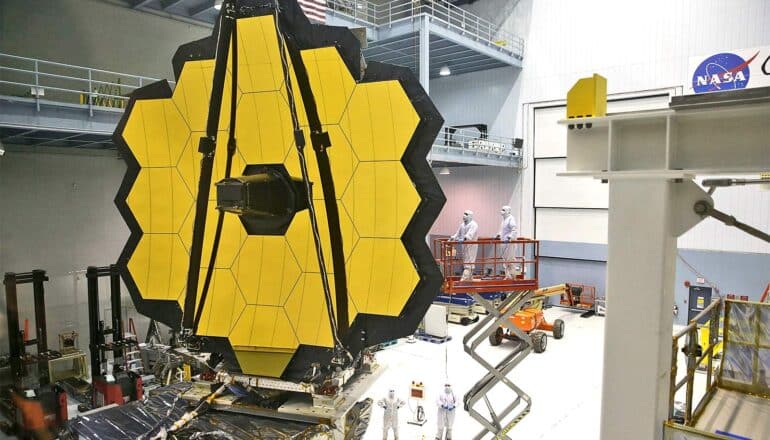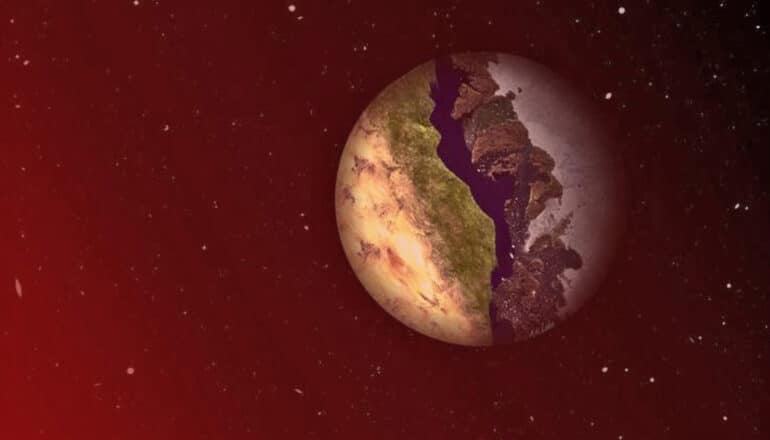
A team of researchers propose using the James Webb Space Telescope to look at five planets in the Venus Zone, a search that could reveal valuable insights into Earth’s future.
Venus floats in a nest of sulfuric acid clouds, has no water, and its surface temperatures are hot enough to melt lead. Despite being such a scorching wasteland, however, the planet is often referred to as Earth’s sister because of similarities in size, mass, density, and volume.
Earth and Venus, which both formed about 4.5 billion years ago, now sit on opposite ends of habitability. This leaves astronomers with a giant question: Is Venus Earth’s past or Earth’s future?
“It’s all about trying to understand why Earth and Venus are so different now,” says Jim Head, a professor of geological sciences at Brown University. “We have Venus to look at here, but there are solar systems out there in which we can actually compare all these different things that we want to know. It’s a whole new parameter of space to explore.”
In the study in the Astronomical Journal, Held and colleagues identify five Venus-like planets from a list of more than 300. The researchers selected these terrestrial planets orbiting other stars, called exoplanets, because they were the most likely to resemble Venus in terms of their radii, masses, densities, the shapes of their orbits, and distances from their stars.
The researchers rank the Venus-like planets depending on the brightness of the stars they orbit to increase the odds that the Webb Telescope gets the clearest view of them, enabling researchers to pull key signals from them regarding the composition of their atmospheres.
The five planets all orbit regions called the Venus Zone, which was coined by astrophysicist and study coauthor Stephen Kane from the University of California, Riverside.
The Venus Zone encompasses the region around a star where it’s too hot for a planet to have water but not too hot for it to have no atmosphere. It is similar to the concept of a habitable zone, which is a region around a star where liquid surface water could exist.
The researchers propose the planets identified in the paper as targets for the Webb telescope in 2024. Webb is NASA’s most ambitious telescope to date and is enabling scientists not only to look into the deep past of the universe but to peer into the atmospheres of exoplanets for telltale signs of what the planet is like.
Studying exoplanets in the Venus Zone could give astronomers a better understanding of whether Venus was ever habitable. The Webb observations the researchers propose, for example, may reveal biosignature gases in the atmosphere such as methane, methyl bromide, or nitrous oxide, which could signal the presence of life. The researchers also hope to see through the observations whether Venus’s lack of plate tectonics is common and whether the planet’s volcanic activity is normal.
These observations will be complemented by NASA’s two upcoming spacecraft missions to Venus. The DAVINCI mission will measure gases in the Venusian atmosphere. The VERITAS mission will enable 3D reconstructions of the landscape.
Combined, the findings will help lead to a better understanding of the Earth-Venus divergence, which could serve as a dire warning for where Earth is heading, the researchers say.
Colby Ostberg, a UC Riverside PhD student, is the study’s lead author. NASA’s Habitable Worlds Program supported the work.
Source: Brown University
The post Hunt for Venus-like planets could shed light on Earth’s future appeared first on Futurity.

Extraterrestrial life has the potential to exist on distant exoplanets inside special areas called “terminator zones,” according to a new study.
The terminator zone is a ring on planets that have one side that always faces its star and one side that is always dark.
“These planets have a permanent day side and a permanent night side,” says lead author Ana Lobo, a postdoctoral researcher in the physics and astronomy department at the University of California, Irvine.
Such planets are particularly common because they exist around stars that make up about 70% of the stars seen in the night sky—so-called M-dwarf stars, which are relatively dimmer than our sun, Lobo says.
The terminator is the dividing line between the day and night sides of the planet. Terminator zones could exist in that “just right” temperature zone between too hot and too cold.
“You want a planet that’s in the sweet spot of just the right temperature for having liquid water,” says Lobo, because liquid water, as far as scientists know, is an essential ingredient for life.
On the dark sides of terminator planets, perpetual night would yield plummeting temperatures that could cause any water to be frozen in ice. The side of the planet always facing its star could be too hot for water to remain in the open for long.
“These new and exotic habitability states our team is uncovering are no longer the stuff of science fiction.”
“This is a planet where the dayside can be scorching hot, well beyond habitability, and the night side is going to be freezing, potentially covered in ice. You could have large glaciers on the night side,” Lobo says.
For the study, which appears in The Astrophysical Journal, Lobo and Aomawa Shields, an associate professor of physics and astronomy, modeled the climate of terminator planets using software typically used to model our own planet’s climate, but with a few adjustments, including slowing down planetary rotation.
It’s believed to be the first time astronomers have been able to show that such planets can sustain habitable climates confined to this terminator region.
Historically, researchers have mostly studied ocean-covered exoplanets in their search for candidates for habitability. But now that Lobo and her team have shown that terminator planets are also viable refuges for life, it increases the options life-hunting astronomers have to choose from.
“We are trying to draw attention to more water-limited planets, which despite not having widespread oceans, could have lakes or other smaller bodies of liquid water, and these climates could actually be very promising,” Lobo says.
One key to the finding, Lobo adds, was pinpointing exactly what kind of terminator zone planet can retain liquid water. If the planet is mostly covered in water, then the water facing the star, the team found, would likely evaporate and cover the entire planet in a thick layer of vapor.
But if there’s land, this effect shouldn’t occur.
“Ana has shown if there’s a lot of land on the planet, the scenario we call ‘terminator habitability’ can exist a lot more easily,” says Shields. “These new and exotic habitability states our team is uncovering are no longer the stuff of science fiction—Ana has done the work to show that such states can be climatically stable.”
Recognizing terminator zones as potential harbors for life also means that astronomers will need to adjust the way they study exoplanet climates for signs of life, because the biosignatures life creates may only be present in specific parts of the planet’s atmosphere.
The work will also help inform future efforts by teams using telescopes like the James Webb Space Telescope or the Large Ultraviolet Optical Infrared Surveyor telescope currently in development at NASA as they search for planets that may host extraterrestrial life.
“By exploring these exotic climate states, we increase our chances of finding and properly identifying a habitable planet in the near future,” says Lobo.
Source: UC Irvine
The post Could ‘terminator zones’ on far off planets harbor life? appeared first on Futurity.